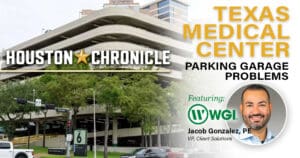
WGI Unleashed Episode 89: Lyndsey Duty, Environmental Scientist
On the latest episode of the WGI Unleashed podcast, we sit down with Lyndsey Duty, one of WGI’s Environmental Scientists based out of our Tampa, FL office!
Learn from award-winning professionals — explore our whitepapers, blogs, and the latest industry updates.
Join our dynamic organization of engineers, land surveyors, landscape architects, environmental scientists, and architects!
Talk to a market leader today! We’ll answer any questions you have about our professional services.

In the realm of transportation, curbs have long been seen as mere boundaries separating roads from sidewalks.
However, with the increased competition for curb space, curbs are now a recognized infrastructure element in their own right. With growing attention to curbs, cities are looking for both near-term solutions and the longer-term ramifications of autonomous vehicles and delivery systems.
In the past, cities regulated curbs with on-street parking regulations, meters, and signs. Deliveries were often directed to alleys in urban areas or building loading zones. The explosion of online commerce, however, has overwhelmed the available loading facilities, with delivery drivers, now under time pressures, often choosing to double park and risk parking tickets rather than navigate alleys and loading docks.
But it’s not just delivery drivers vying for space. Drivers tend to value on-street parking over garages or periphery parking. Valet services and law enforcement also use curbside parking. And ride-hailing services such as Uber and Lyft have elevated conversations on curbs due to the wild west nature of pick-up and drop-off.
We’ve all seen the parking sign clutter where five (or more) signs are needed to allocate space, and transportation is not the only use. The pandemic has also demonstrated the pent-up demand for outdoor dining as a regular feature of downtowns.
At WGI, we’ve helped several cities develop solutions using innovative planning, policy innovation design, and new technologies. One of the main changes is to view curbs as real estate that needs to respond dynamically to shifting demand throughout the day – and evening. Where there is high demand, cities can transition to performance-based planning. With a performance-based model, cities establish performance benchmarks. For parking, setting a goal of 85% occupancy is common. At this level, parking assets are well used though there are open spaces for new arrivals. If occupancy rises above the 85% target, managers use pricing or other methods to curb parking demand.
Another parking solution comes in the form of better use of periphery parking. Many cities don’t have a parking shortage, but rather, drivers are unaware of the location of open parking spaces. One of the most important uses of technology is real-time information on available parking. The trick is to not only post information at garage entrances but also make information known to drivers via navigation apps and bypass signage at the edge of downtown. In addition, on-demand and fixed route circulators are gaining popularity in downtowns and can be used to shuttle drivers and employees between periphery parking and destinations. Periphery parking may also provide more advantageous locations for charging facilities, given the lower level of activity.
Bicycle lanes require space, whether shared with vehicles or physically separated from traffic. The recent infrastructure law boosted attention and funding for Complete Streets, which supports a balanced mode split among walking, biking, transit, and automobiles. As highlighted in this article, however, the definition of complete increasingly encompasses more than modes. WGI is currently working with the American Planning Association to update resources on Complete Streets and will include consideration of the multiplicity of demands in streets and along curbs.
Of note, handicap accessibility and parking need to be at the center of the design. The recent release of technical guidelines from the U.S. Access Board is called Public Right-of-Way Accessibility Guidelines (or PROWAG). These design rules implement the Americans with Disabilities Act (ADA), and issue required dimensions for facilities such as loading zones and parking spaces.
With new technologies, cities can also begin to manage curbs in real time. By instituting “programmable curbs,” cities can replace the complex and cluttered signs mentioned prior with signs that alert drivers to curb availability in real time. This type of system, as illustrated below, would use dynamic signs and paint to let drivers know which uses are available and at which price point. For example, a city can use data to find which hours have the highest delivery demand and allocate space accordingly.
Five years ago, transportation industry reports were replete with articles on the imminent arrival of autonomous vehicles, including robotaxis and delivery bots. Given the complexity of vibrant urban streetscapes, the rollout has taken more time than expected. Even so, companies are iterating to learn from mistakes and improve the technology and software needed for services that rival or exceed those undertaken by human operators. Moreover, new automobiles in the United States currently offer “driver-assist” or semi-automated parking and maneuvering.
What is the status of automated delivery services? First – the goal of automated delivery services (ADS) is timely service without disrupting traffic or jeopardizing the safety of pedestrians, cyclists, and other road users. A new report from the standard-setting organization SAE titled “AVs and Infrastructure Enablers: Curbs and Curbside Management” provides insights. Lisa Nisenson, WGI’s VP for New Mobility & Connected Communities, contributed to this report. The report uniquely treats how AVs affect urban design, infrastructure, and public works. The following key points reflect this multi-disciplinary view:
As we navigate the evolving landscape of mobility, recognizing the pivotal role of curbs is not just a necessity—it’s a pathway to transformative change in managing multi-use spaces. To purchase a copy of the report, please visit SAE’s website.
Download one of our whitepapers to learn more:
And contact our team today to discuss how we can apply our expertise to your next project!

WGI is a national design and professional services firm leading in technology-based solutions for the construction of public infrastructure and real estate development. At WGI, we’re providing Tomorrow’s Infrastructure Solutions Today.

On the latest episode of the WGI Unleashed podcast, we sit down with Lyndsey Duty, one of WGI’s Environmental Scientists based out of our Tampa, FL office!

WGI’s San Antonio team laced up their running shoes and braved the rain to take on the iconic Rock and Roll 5K – Discover how they turned challenges into triumphs in this memorable event recap!

With a legacy of supporting, empowering, & inspiring women in transportation, the WTS Central Florida’s Annual Awards & Scholarship Banquet was nothing short of a night to remember.

Discover how Austin is transforming urban development with proposed zoning changes, inclusive housing initiatives, and creative space preservation—all while embracing growth and sustainability.

Texas Medical Center made $78M from parking last year. Why haven’t its busiest garages been upgraded in years?

Discover how WGI helped bring Lively Lane to life—a vibrant community in San Marcos that blends sustainable design, live/work townhomes, and natural beauty to create the perfect balance of urban convenience and serenity.
You’ve been searching for a place like WGI. We look forward to meeting you soon.
Sign up to receive emails to hear our latest news and achievements in our monthly newsletter.
Enter your zip code, and we’ll personalize your experience with local projects, office locations, team members, and more.
WGI supports its associates with meaningful opportunities for growth, strong benefits and perks, while we work collaboratively with clients and co-consultants to shape and improve communities.






WGI is a dynamic organization with opportunities nationwide for engineers, land surveyors, landscape architects, environmental scientists, and architects.